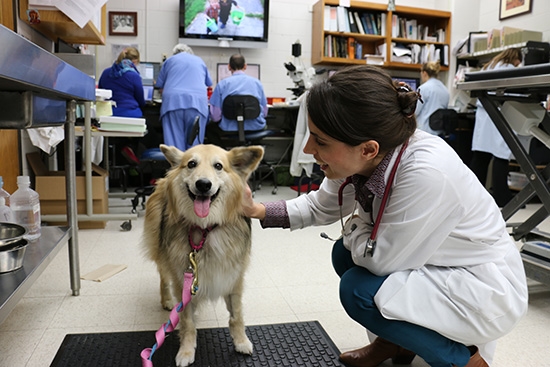Study reveals possible biological trigger for canine bone cancer

UW–Madison School of Veterinary Medicine intern Kathleen Tsimbas checks on Yurtie in the UW Veterinary Care oncology ward
Researchers at the University of Wisconsin-Madison School of Veterinary Medicine (SVM) have identified the biological mechanism that may give some cancer cells the ability to form tumors in dogs. The findings, published in the journal Veterinary and Comparative Oncology on Feb. 16, may eventually provide oncologists with another target for therapy and improve outcomes for canine patients with the disease.
The study uncovered an association between the increased expression of a particular gene in tumor cells and more aggressive behavior in a form of canine bone cancer. It may also have implications for human cancers by detailing a new pathway for tumor formation.
The researchers examined cell lines generated from dogs with osteosarcoma, a common bone cancer that also affects people, with the intent of uncovering why only some cells generate tumors. After the dogs underwent tumor-removal surgery, cells from the tumors were grown in the lab.
This led to six different cancer cell lines, which were then transplanted into mice. The researchers then looked to see which lines developed tumors and which did not and studied the differences between them.
"We found several hundred genes that expressed differently between the tumor-forming and non-tumor-forming cell lines," says Timothy Stein, an assistant professor of oncology. However, one protein called frizzled-6 was present at levels eight times higher in cells that formed tumors.
Stein hopes to continue this line of research in human cancer patients. Meanwhile, the lead author on the study, Lucas Rodrigues, is continuing the investigation in dogs.
"Now we want to make sure that frizzled-6 is truly what gives these cells the ability to form new tumors," says Rodrigues, a postdoctoral fellow in Stein’s lab.
While frizzled-6 may be the lone culprit, it is possible that a combination of multiple genes may lead to tumor formation, says Rodrigues.
Photo courtesy of Nik Hawkins/UW–Madison School of Veterinary Medicine



